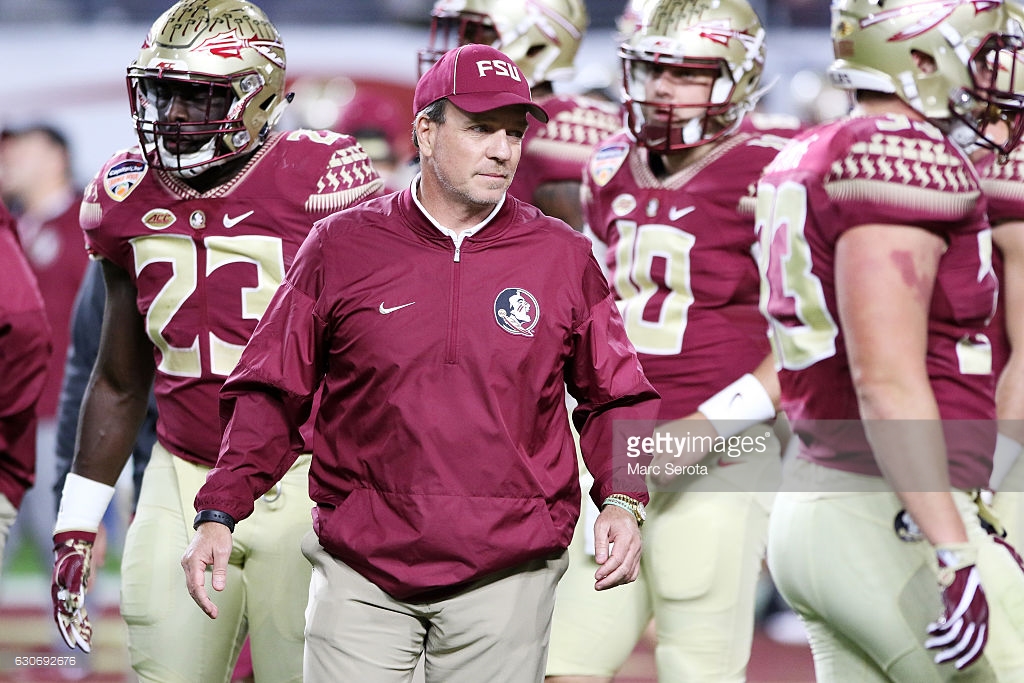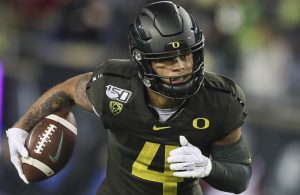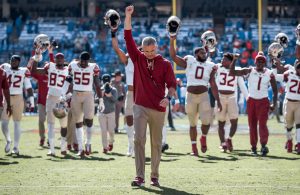- Sunday Seminole Summary: FSU Football Adds Pair of WR Transfers
- Sunday Seminole Summary: FSU Football Exits ESD With Top-15 Class
- Sunday Seminole Summary: FSU Soccer Tops BYU for Third National Championship
- Sunday Seminole Summary: FSU Soccer Advances to National Championship Match
- Seminole Sunday Summary: FSU Soccer Heads Back to College Cup
- Seminole Sunday Summary: FSU Soccer Reaches Sweet 16; Football Tops Boston College
- Seminole Sunday Summary: FSU Soccer Wins ACC, Advances to Second Round of NCAA Tournament; FSU Football Rallies Past Miami
- Seminole Sunday Summary: FSU Soccer Tops Wake on OT to Advance to ACC Final
- Seminole Sunday Summary: FSU Football Crushes UMass for Third Straight Win
- Seminole Sunday Summary: FSU Soccer Stays Perfect with Pair of Wins
The State of FSU Football Post-2016
- By Clint Eiland
- Updated: December 31, 2016
 Marc Serota/Getty Images
Marc Serota/Getty ImagesYes, Florida State fans, the Orange Bowl victory was real. Many woke up Saturday morning wondering if they had dreamed the nonsensical ending all in their head, but it was real, and Friday night’s victory signifies just how resilient the FSU football team actually is.
Head coach Jimbo Fisher is now 5-2 in bowl games and brought the Seminoles to five straight BCS/New Year’s Six bowls. Florida State came in as an underdog. It left as Orange Bowl champions.
In many ways, it vindicates the Seminoles as a program. Two straight major bowl losses by 14-plus points left many doubting if Fisher had “lost his touch†so to speak. If he couldn’t beat teams like Oregon and Houston, how was he going to beat a Michigan team that was in the thick of the playoff hunt late in the season? Especially considering how the FSU season had been up to that point?
The victory over Michigan is huge for Florida State. It showcased Fisher’s coaching ability and highlighted the talent present on the team. But one game is not completely indicative of the state of a program.
The common move is to look at pure wins and losses to determine the future of a team. In some ways this can help, but it is only one factor in a laundry list of things like recruiting talent, advanced metrics and staff changes. Florida State finished this season with three losses, but that isn’t necessarily all that telling when it comes to the state of the program.
To help answer this question, here’s a table below of S&P overall ranking, S&P offense ratings, and S&P defense ratings (the S&P ratings for 2016 are pre-Orange Bowl and will be adjusted once the updated numbers are released).
| Seasons | S&P Overall | S&P Offense | S&P Defense |
| 2008 | 50 | 63 | 42 |
| 2009 | 41 | 11 | 80 |
| 2010 | 11 | 21 | 8 |
| 2011 | 23 | 63 | 5 |
| 2012 | 16 | 41 | 10 |
| 2013 | 1 | 4 | 7 |
| 2014 | 22 | 16 | 40 |
| 2015 | 7 | 22 | 10 |
| 2016 | 9 | 6 | 18 |
Here’s what those numbers tell us: Fisher-led FSU teams have a high floor. The end of the Bobby Bowden era showed fans that the program could bottom out when the coaching became lousy and the talent stopped pouring in. Fisher’s promotion in 2010 brought much-needed stability to the team.
The results are readily apparent. He has had a top 25 offense every year since 2012 and never let the team as a whole get below 25th in the S&P rankings. When it comes to offense, there should not be any worry around FSU. Its coach has proven himself enough to put together a highly-rated unit each year.
Of course, that is only one side of the ball. The defense is where many fans have (justifiably) directed their anger to.
This is also where the S&P ratings might not fully capture the whole picture. Florida State struggled mightily in the first half of the season, letting teams with lesser talent and experience move the ball aggressively down the field. This issue has been discussed more in depth elsewhere, but it should still be noted. The defense did rally towards the end of the season, but bottoming out at 79th overall five games in should never occur. If there are any changes to be made, it will be here.
On another note, there’s a general sentiment that getting seven or eight wins in the ACC should be automatic for FSU, but recent changes in the college football landscape have altered that dynamic. The ACC as a conference has quickly ascended near the top of ratings systems, meaning Florida State’s “guaranteed†wins are reduced in number.
By and large, the Seminoles still beat the teams they are supposed to beat. Some will object and point out losses like Georgia Tech in 2015 or North Carolina this year. But here’s the bottom line: Unless you’re Nick Saban or Urban Meyer, those types of losses will happen.
Every other coach in Fisher’s tier has had a head-scratching loss. Heck, even Meyer and Saban aren’t completely immune to it. Ohio State famously lost to 7-6 Virginia Tech in 2014, and Alabama lost to 9-4 Ole Miss in the same year.
Perhaps the brightest spot on the horizon for FSU is its recruiting. The Seminoles continue to bring in elite talent on par with teams like Ohio State and LSU. It’s not unevenly distributed either: in the last two classes, the Seminoles have brought in 14 offensive blue chip players and 16 defensive blue chip players. Not all of them have worked out, but the Seminoles are still hitting at a clip consistent with national title contenders.
Injuries this past season may have given an inaccurate impression of defensive depth. The talent is there, but the experience might not be. This in of itself is one area that will likely be notable going into 2017.
Florida State loses defensive end DeMarcus Walker and cornerback Marquez White, but freshmen like defensive end Brian Burns and defensive backs Kyle Meyers, Carlos Becker, and Levonta Taylor all got significant reps this season. This means there probably won’t be a situation like the safety position in 2016, where A.J. Westbrook was getting more time than the staff ever planned for.
Trying to compact such a discussion in one sentence is impossible. If one had to summarize the situation, it’d be this: Florida State has the talent to compete for a national title. Jimbo Fisher is still a top 5 coach in the nation and will have the offense humming as long as he is attentive.
The defense also has the talent to be elite, but the coaching will need to experience some sort of upgrade or change in order to succeed. Even if the latter reality doesn’t happen, FSU is a lock to win at least nine games for the next couple of years.
Should FSU settle for that, if it really does occur? Probably not. But it is a testament to the strength of the program that this is the worst case scenario.




You must be logged in to post a comment Login